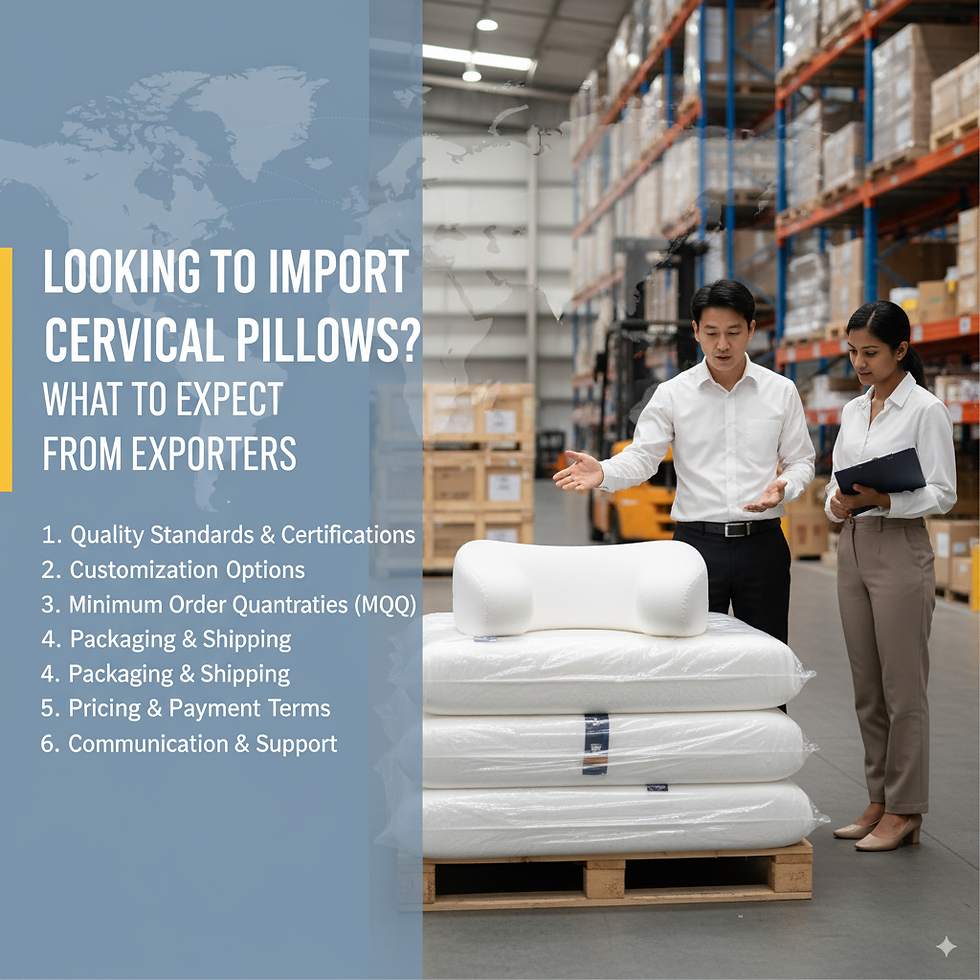Why 80% of First-Time Neck Pillow Distributors Fail (And How to Avoid It)
- cdeastshore1
- Aug 26
- 4 min read

In the booming travel and wellness industry, neck pillows have emerged as a must-have accessory for weary travelers, office workers, and anyone seeking ergonomic relief. With the global travel pillow market projected to grow from $2.33 billion in 2025 to $3.98 billion by 2034, it's no wonder aspiring entrepreneurs are jumping into distribution. Yet, statistics paint a grim picture: around 80% of first-time distributors fail within their initial years, often due to avoidable pitfalls. This figure aligns with broader small business failure rates, where over 75% of small distributors survive the first year, but many crumble soon after due to systemic issues. Drawing from industry insights, this blog explores the top reasons behind these failures—tailored to the neck pillow niche—and provides actionable strategies to beat the odds. Whether you're sourcing memory foam U-shaped pillows or inflatable variants, understanding these missteps can turn your venture from a statistic to a success story.
Reason 1: Inadequate Market Research and Misunderstanding Demand
One of the most common blunders for novice distributors is diving in without thorough market research. Neck pillows seem like a straightforward product—everyone travels, right? But the market is saturated with low-cost alternatives flooding online platforms and retail shelves, making differentiation tough. First-timers often overestimate demand, assuming trendy items like cervical support pillows will sell themselves. In reality, 42% of small businesses fail because there's no real market need, a trap that's especially prevalent in consumer goods like travel accessories where trends shift rapidly.
For neck pillows, challenges include intense competition from established brands and price-sensitive consumers who opt for cheap imports over premium options. Beginners might stock up on generic designs without considering regional preferences—e.g., memory foam dominates in North America for comfort, while inflatable ones appeal in Asia for portability. Without data on target demographics, such as frequent flyers or remote workers, inventories gather dust, leading to cash flow crises.
How to Avoid It: Start with comprehensive research. Use tools like Google Trends or market reports to analyze search volumes for "best travel neck pillow" and identify gaps, such as eco-friendly materials or customizable designs. Survey potential customers via social media or focus groups. Partner with platforms like Shopify for initial testing—launch a minimum viable product (MVP) with small batches to gauge interest before scaling. This data-driven approach can reduce failure risk by ensuring your offerings align with actual demand.
Reason 2: Supply Chain and Supplier Mismanagement
Supply chain woes plague many first-time distributors, especially in the neck pillow sector where raw materials like foam and fabrics are sourced globally. Novices often choose unreliable manufacturers to cut costs, leading to quality inconsistencies, delays, and defective products. For instance, during the pandemic, pillow manufacturers faced raw material shortages and transportation bottlenecks, causing production slowdowns that ripple to distributors. Poor supplier performance is a top issue, with inefficient inventory management exacerbating problems like stockouts or overstocking.
In the neck pillow market, environmental regulations add complexity—consumers demand sustainable options, but cheap suppliers might use non-compliant materials, risking recalls or bad reviews. Beginners also underestimate lead times; excessively long ones from overseas factories can miss peak seasons like summer travel booms, resulting in lost sales.
How to Avoid It: Vet suppliers rigorously. Look for certified manufacturers offering bulk wholesale, like those specializing in cervical pillows with ISO compliance. Start small with samples to test quality—check for durability, odor, and support. Diversify suppliers to mitigate risks, and use software like Cin7 for real-time tracking. Build relationships by negotiating flexible terms, such as minimum order quantities that suit startups. This ensures consistent supply, maintaining product quality and customer trust.
Reason 3: Weak Marketing and Sales Strategies
Many first-timers believe "if you build it, they will come," but this fallacy dooms distributions. In the digital age, neck pillow distributors fail at online presence, with 8 common digital mistakes like unrealistic e-commerce expectations or ignoring SEO. Without a solid go-to-market strategy, products languish unseen. For travel accessories, marketing must highlight benefits like pain relief during flights, yet beginners skimp on content, leading to low visibility amid competitors.
Sales reps often lack resources, resulting in error-prone orders or missed opportunities. Distributors also overlook channels like Amazon or airport kiosks, where impulse buys thrive.
How to Avoid It: Craft a robust marketing plan. Invest in content distribution—avoid mistakes like targeting everyone by focusing on niches like business travelers. Use AdWords for branded searches, positioning your pillows as superior alternatives. Leverage social proof with influencers reviewing your ergonomic designs. Track metrics like customer acquisition cost (CAC), assuming it won't stay static, and adjust tactics. Train sales teams with apps for accurate ordering, reducing errors.
Reason 4: Inventory and Operational Inefficiencies
Inventory mismanagement is a killer, with inconsistent stock levels causing waste or lost sales. First-time distributors often base choices on hype rather than data, overstocking trendy but short-lived items like novelty-shaped neck pillows. In distribution centers, mistakes like not planning for egress or automating too much lead to operational chaos. For neck pillows, seasonal demand spikes (e.g., holidays) catch unprepared distributors off-guard.
How to Avoid It: Implement inventory software for real-time visibility and forecasting. Use data from past sales to optimize portfolios, avoiding excess. Involve material handling experts early in warehouse planning. Start lean, scaling as demand proves sustainable.
Reason 5: Financial Mismanagement and Scaling Prematurely
Cash flow issues sink 29% of businesses, with distributors spreading too thin digitally or branching out excessively. First-timers go big too fast, investing in wrong platforms or staff mixes without knowing customers.
How to Avoid It: Bootstrap initially—start with $6,000 like one pillow entrepreneur, focusing on essentials. Monitor finances closely, avoiding over-investment. Seek mentorship through programs for operational skills.
Conclusion: Turning the Tide for Your Distribution Business
The 80% failure rate for first-time neck pillow distributors isn't inevitable—it's a warning sign. By prioritizing research, solid suppliers, marketing, inventory, and finances, you can thrive in this growing market. Remember, success comes from learning from others' mistakes. With diligence, your venture could support countless necks and build a lasting empire.



Comments